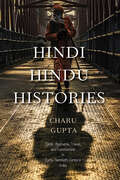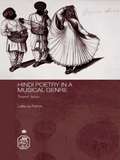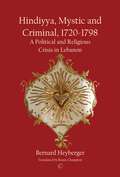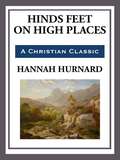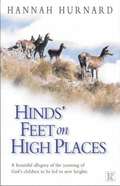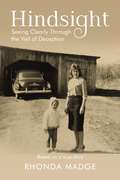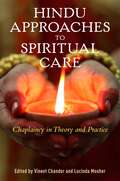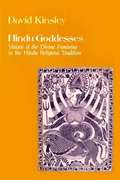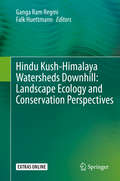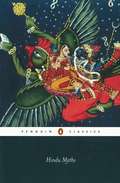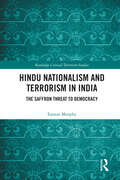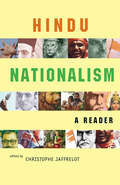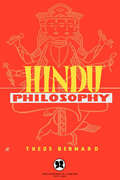- Table View
- List View
Hindi Christian Literature in Contemporary India (Routledge Studies in Religion)
by Rakesh Peter-DassThis is the first academic study of Christian literature in Hindi and its role in the politics of language and religion in contemporary India. In public portrayals, Hindi has been the language of Hindus and Urdu the language of Muslims, but Christians have been usually been associated with the English of the foreign ‘West’. However, this book shows how Christian writers in India have adopted Hindi in order to promote a form of Christianity that can be seen as Indian, desī, and rooted in the religio-linguistic world of the Hindi belt. Using three case studies, the book demonstrates how Hindi Christian writing strategically presents Christianity as linguistically Hindi, culturally Indian, and theologically informed by other faiths. These works are written to sway public perceptions by promoting particular forms of citizenship in the context of fostering the use of Hindi. Examining the content and context of Christian attention to Hindi, it is shown to have been deployed as a political and cultural tool by Christians in India. This book gives an important insight into the link between language and religion in India. As such, it will be of great interest to scholars of Religion in India, World Christianity, Religion and Politics and Interreligious Dialogue, as well as Religious Studies and South Asian Studies.
Hindi Hindu Histories: Caste, Ayurveda, Travel, and Communism in Early-Twentieth-Century India (SUNY series in Hindu Studies)
by Charu GuptaExplores how four public intellectuals in North India imagined freedom and Hindi-Hindu nationhood through their writings on caste, Ayurveda, travel, and communism.What did everyday Hinduism in India look like a hundred years ago? Were its practices more varied and less politically curtailed than now? Hindi Hindu Histories provides illuminating historical accounts of Hindu life through individual actors, autobiographical narratives, and genres in the Hindi print-public culture of early twentieth-century North India. It focuses on four fascinating figures: a successful woman doctor in the Indigenous medical regime, a globe-trotting Hindu ascetic who opposed Gandhi, an anticaste campaigner who spoke for sexual equality, and a Hindu communist who envisioned an egalitarian utopia in the world of labor. These public intellectuals harbored vernacular dreams of freedom and Hindi-Hindu nationhood through their vantage points of caste, Ayurveda, travel, and communism. Opening up a vast and under-explored Hindi archive, this book presents a dynamic spectacle of a plural Hindi-Hindu universe of facets that coexisted, challenged each other, and comprised an idea of Hinduness far more inclusive than anything conceivable in the present moment.
Hindi Poetry in a Musical Genre: Thumri Lyrics (Royal Asiatic Society Books)
by Lalita du PerronIndian classical music has long been fascinating to Western audiences, most prominently since the Beatles' sessions with Ravi Shankar in the 1960s. This fascination with the musical genre still prevails in the twenty-first century. Hindi Poetry in a Musical Genre examines Thumri Lyrics, a major genre of Hindustani music, from a primarily linguistic perspective. On a cultural level, it discusses the interface between devotional and secular poetry. Furthermore, it explains the impact of social and political change on the musical life on North India. Well-written and thoroughly researched, this book is a valuable contribution to the field of South Asian studies. It will be interesting to academics across the discipline, including linguistics, politics, sociology, cultural and gender studies.
Hindiyya, Mystic and Criminal, 1720-1798: A Political and Religious Crisis in Lebanon
by Bernard HeybergerIn this compelling narrative, Bernard Heyberger relates the fascinating history of Hindiyya 'Ujaymi, a highly charismatic eighteenth-century mystic of sinister repute. Heyberger makes a careful study of Hindiyya's life from earliest childhood, with a detailed picture of her formative years in the eighteenth century Christian community of Aleppo, the domestic reality of which is little known, exploring the influences she would have experienced. He leads us through her spiritual development under the direction of the Jesuits, her determination to found a new religious order, and the tragic history of its collapse in a welter of paranoia and persecution. Heyberger also reveals the tensions and complex rivalries at play around Hindiyya between Rome, the Jesuits, and Eastern tribes, which were also beset by feuds and alliances. He makes extensive use of a wide variety of sources, from Hindiyya's own writings to reports from her confessors and Roman inquisitors, to shed light upon the Hindiyya affair. 'Hindiyya, Mystic and Criminal' relates the history of a woman of inflexible power of will and great charisma, who managed to move beyond the circumscribed world of her girlhood and realise what she believed to be her destiny. It will be of great interest to anyone seeking a deeper understanding of an affair which has been long obscured by contradictory reports, or to those interested in eighteenth-century Maronite Christianity and its complex interactions with the authority of Rome.
Hinds Feet on High Places
by Hannah HurnardMuch-Afraid had been in the service of the Chief Shepherd, whose great flocks were pastured down in the Valley of Humiliation. She lived with her friends and fellow workers Mercy and Peace in a tranquil little white cottage in the village of Much-Trembling. She loved her work and desired intensely to please the Chief Shepherd, but happy as she was in most ways, she was conscious of several things which hindered her in her work and caused her much secret distress and shame. Here is the allegorical tale of Much-Afraid, an every-woman searching for guidance from God to lead her to a higher place.
Hindsight: Seeing Clearly through the Veil of Deception
by Rhonda Taylor MadgeIn Joyce Meyer&’s bestselling book, Battlefield of the Mind, she attests that indeed &“there is a war which rages in our minds.&” Hindsight takes readers on a journey through Rhonda Madge&’s tumultuous life to reveal how she fell prey to anxious thoughts that molded her mind through a belief in the whispered lies.A horrific event at the age of seventeen left Rhonda continually searching for something or someone to fill the dark chasm of her heart. Tears seemed to puddle around her wherever she went. However, she learned to carefully hide herself in a masquerade put on for the outside world, allowing her to project that all was well with her soul even as the slow decay continued from within. Those who find themselves pretending will be drawn to the answers her story presents.But it was God who worked to lift the veil from Rhonda&’s eyes, allowing her to see that, though she thought He was far from her, He remained at arm&’s length. Thus a seeker&’s interest will be peeked as they read about Rhonda&’s exploration of who and what God truly is--a loving, personal God. Those who struggle with life&’s hardships will be encouraged and inspired to practice Rhonda&’s perseverance.In a world where sorrow is often heaped upon sorrow, this very real story bares truth that will leave readers filled with hope.
Hindu Approaches to Spiritual Care: Chaplaincy in Theory and Practice
by Lucinda Mosher Vineet ChanderShowing how spiritual care is practiced in a variety of different contexts such as healthcare, detention and higher education, as well as settings that may not have formal chaplaincy arrangements, this book offers an original and unique resource for Hindu chaplains to understand and practice spiritual care in a way that is authentic to their own tradition and that meets the needs of Hindus. It offers a Hindu perspective for all chaplains to inform their caregiving to Hindus.The book explores the theological and metaphysical roots of Hindu chaplaincy and puts forward the case for Hindu chaplaincy as a valuable spiritual practice. It covers the issues that arise in specific locations, such as college, healthcare, prison, military and the corporate sector. Chapters also examine Hindu pastoral care offered in other, 'non-chaplaincy' settings, such as LGBT centres, social justice work and environmental activism.Made up of some 30 essays by chaplains, scholars and other important voices in the field, Hindu Approaches to Spiritual Care provides spiritual caregivers with a comprehensive theoretical and practical approach to the relationship of Hinduism and chaplaincy.
Hindu Bhakti Through Muslim Eyes: Islam and Caitanya Vaiṣṇavism in the Twenty-First Century (Routledge Studies in Religion)
by R. David CoolidgeHindu Bhakti Through Muslim Eyes puts the Caitanya Vaiṣṇava tradition of devotion to Krishna in scholarly conversation with Islam for the first time. It builds on a millennium of Muslim reflections regarding Hindu theology and practice, despite common assumptions that Hindus and Muslims are destined for misunderstanding and conflict. Beginning with al-Bīrūnī in the 11th Century, Muslims often commented on the beliefs and practices of the Hindu tradition in relation to their own tradition of Islam. This process continues until today, as Muslims increasingly articulate a scholarly perspective on our planet's religious diversity. Centered in the author’s Islamic theological, ethical, and liturgical commitments, this study explores the tradition of Krishna worship traced to the charismatic figure Caitanya who preached in the Bengal Sultanate of the early 16th Century. The book explores possibilities for Muslim interreligious scholarship beyond Judeo-Christian frameworks, as well as the revival of al-Bīrūnī's legacy in the 21st Century. Relevant for scholars in Islamic Studies, Hindu Studies, Interreligious Studies, Comparative Theology, and Decolonial Studies, Hindu Bhakti Through Muslim Eyes forges new ground in Muslim scholarship regarding religious and cultural pluralism. In particular, it offers a model of engagement built on patient learning of a different textual corpus and communal praxis, while still remaining rooted in the Islamic tradition as a distinctive intellectual paradigm.
Hindu Customs and their Origins (Routledge Revivals)
by Stanley RiceHindu Customs and their Origins (1937) primarily examines the topic of caste in India, looking at the ancient ideas of the origins of caste and testing modern theories through a critical examination. It also looks at the veneration for the ox and cow, a custom that is unique to India.
Hindu Goddesses
by David R. KinsleyGoddess worship has long been a significant aspect of Hinduism. In this book David Kinsley, author of The Sword and the Flute--Kali & Krsna: Dark Visions of the Terrible and the Sublime in Hindu Mythology, sorts out the rich yet often chaotic history of Hindu goddess worship.
Hindu Goddesses: Visions of the Divine Feminine in the Hindu Religious Tradition
by David R. KinsleyGoddess worship has long been a significant aspect of Hinduism. In this book David Kinsley, author of The Sword and the Flute--Kali & Krishna: Dark Visions of the Terrible and the Sublime in Hindu Mythology, sorts out the rich yet often chaotic history of Hindu goddess worship.
Hindu Gods and Goddesses: 300 Illustrations from "The Hindu Pantheon"
by Edward MoorReflecting the spirit of East Indian myths, legends, and fables, these illustrations were compiled by one of the nineteenth century's foremost Orientalists. Edward Moor published The Hindu Pantheon in 1810, and this new volume draws upon his exposition of India's religious iconography to offer a spectacular array of images of Hindu deities.Dramatic engravings and line drawings include scenes from the Ramayana and Mahabharata as well as temple images of Krishna, Vishnu, Siva, and other major gods and goddesses. Many are derived from bronze figurines; others are reproduced from manuscript illustrations. All appear with captions for ease of identification.
Hindu Histories: The Beginnings
by Nipun ShuklaThe basis of the work is in the assumption that Hindu myths are poetic (hyperbolic) forms of ancient social and political realities. The work builds on this assumption and moves on two intertwined paths.
Hindu Kush-Himalaya Watersheds Downhill: Landscape Ecology and Conservation Perspectives
by Falk Huettmann Ganga Ram RegmiThis book describes the myriad components of the Hindu Kush-Himalaya (HKH) region. The contributors elaborate on challenges, failures, and successes in efforts to conserve the HKH, its indigenous plants and animals, and the watershed that runs from the very roof of the planet via world-rivers to marine estuaries, supporting a human population of some two billion people. Readers will learn how the landforms, animal species and humans of this globally fascinating region are connected, and understand why runoff from snow and ice in the world’s tallest mountains is vital to inhabitants far downstream. The book comprises forty-five chapters organized in five parts. The first section, Landscapes, introduces the mountainous watersheds of the HKH, its weather systems, forests, and the 18 major rivers whose headwaters are here. The second part explores concepts, cultures, and religions, including ethnobiology and indigenous regimes, two thousand years of religious tradition, and the history of scientific and research expeditions. Part Three discusses policy, wildlife conservation management, habitat and biodiversity data, as well as the interaction of animals and humans. The fourth part examines the consequences of development and globalization, from hydrodams, to roads and railroads, to poaching and illegal wildlife trade. This section includes studies of animal species including river dolphins, woodpeckers and hornbills, langurs, snow leopards and more. The concluding section offers perspectives and templates for conservation, sustainability and stability in the HKH, including citizen-science projects and a future challenged by climate change, growing human population, and global conservation decay. A large assemblage of field and landscape photos, combined with eye-witness accounts, presents a 50-year local and wider perspective on the HKH. Also included are advanced digital topics: data sharing, open access, metadata, web portal databases, geographic information systems (GIS) software and machine learning, and data mining concepts all relevant to a modern scientific understanding and sustainable management of the Hindu Kush-Himalaya region. This work is written for scholars, landscape ecologists, naturalists and researchers alike, and it can be especially well-suited for those readers who want to learn in a more holistic fashion about the latest conservation issues.
Hindu Matham
by Uma SampathThe book traces the history of Hindu Religion, the ancient religion of the majority of the population of India and touches various treasures of Hinduism such as Puranas, Upanishads, Epics, Vedas, Four Varnas and Hindu culture, customs and traditions.
Hindu Mission, Christian Mission: Soundings in Comparative Theology (SUNY series in Religious Studies)
by Reid B. LocklinFor some four hundred years, Hindus and Christians have been engaged in a public controversy about conversion and missionary proselytization, especially in India and the Hindu diaspora. Hindu Mission, Christian Mission reframes this controversy by shifting attention from "conversion" to a wider, interreligious study of "mission" as a category of thought and practice. Comparative theologian Reid B. Locklin traces the emergence of the nondualist Hindu teaching of Advaita Vedānta as a missionary tradition, from the eighth century to the present day, and draws this tradition into dialogue with contemporary proposals in Christian missiology. As a descriptive study of the Chinmaya Mission, the Ramakrishna Mission, and other leading Advaita mission movements, Hindu Mission, Christian Mission contributes to a growing body of scholarship on transnational Hinduism. As a speculative work of Christian comparative theology, it develops key themes from this engagement for a new, interreligious theology of mission and conversion for the twenty-first century and beyond.
Hindu Monotheism (Elements in Religion and Monotheism)
by Gavin Dennis FloodIf by monotheism we mean the idea of a single transcendent God who creates the universe out of nothing (creatio ex nihilo), as in the Abrahamic religions, then that is not found in the history of Hinduism. But if we mean a supreme, transcendent deity who impels the universe, sustains it and ultimately destroys it before causing it to emerge once again, who is the ultimate source of all other gods who are her or his emanations, then this idea does develop within that history. It is a Hindu monotheism and its nature that is the topic of this Element.
Hindu Mysticism
by S. N. SasguptaThis 1927 classic is a systematic introduction to Hindu mysticism as it evolved in India through the ages. This book gives a brief general outline of some of the most important types of mysticism, indicating their mutual relations, sometimes genetically and sometimes logically. These include early sacrificial, Upanisadic, Yogic, Buddhistic, and Classical as well as Popular Bhakti cult explaining concisely and clearly their main characteristics, basing the interpretations directly on the original sources.
Hindu Myths: A Sourcebook Translated from the Sanskrit
by Wendy DonigerRecorded in sacred Sanskrit texts, including the Rig Veda and the Mahabharata, Hindu Myths are thought to date back as far as the tenth century BCE. Here in these seventy-five seminal myths are the many incarnations of Vishnu, who saves mankind from destruction, and the mischievous child Krishna, alongside stories of the minor gods, demons, rivers and animals including boars, buffalo, serpents and monkeys. Immensely varied and bursting with colour and life, they demonstrate the Hindu belief in the limitless possibilities of the world - from the teeming miracles of creation to the origins of the incarnation of Death who eventually touches them all.
Hindu Nationalism and Terrorism in India: The Saffron Threat to Democracy (Routledge Critical Terrorism Studies)
by Eamon MurphyThis book discusses terrorism and the rise of Hindu nationalism in contemporary India and examines how this movement has become a threat to democracy in the country. The work analyses the rise of Hindu nationalism, culminating in the success of Narendra Modi’s Bharatiya Janata Party (BJP), the political arm of the movement, in the 2019 Indian national elections. It offers an accessible account of the complexities and subtleties of Hindu nationalism and the dangers it poses to India’s pluralistic democracy and secularism. A major theme of the book is the role that terrorism has played in the rise of Hindu nationalism, a factor often underplayed or ignored in other studies, and it also challenges the widespread belief that terrorism is largely an Islamic phenomenon. Employing a cross-disciplinary approach, the book is highly relevant to both academics and policymakers, given India’s importance as a major global economic and military power. This book will be of interest to students of terrorism and political violence, South Asian history, Indian politics and international relations, as well as policymakers.
Hindu Nationalism: A Reader
by Christophe JaffrelotHindu nationalism came to world attention in 1998, when the Hindu nationalist Bharatiya Janata Party (BJP) won national elections in India. Although the BJP was defeated nationally in 2004, it continues to govern large Indian states, and the movement it represents remains a major force in the world's largest democracy. This book presents the thought of the founding fathers and key intellectual leaders of Hindu nationalism from the time of the British Raj, through the independence period, to the present. Spanning more than 130 years of Indian history and including the writings of both famous and unknown ideologues, this reader reveals how the "Hindutuva" movement approaches key issues of Indian politics. Covering such important topics as secularism, religious conversion, relations with Muslims, education, and Hindu identity in the growing diaspora, this reader will be indispensable for anyone wishing to understand contemporary Indian politics, society, culture, or history.
Hindu Perspectives on Evolution: Darwin, Dharma, and Design (Routledge Hindu Studies Series)
by C. Mackenzie BrownProviding new insights into the contemporary creationist-evolution debates, this book looks at the Hindu cultural-religious traditions of India, the Hindu Dharma traditions. By focusing on the interaction of religion and science in a Hindu context, it offers a global context for understanding contemporary creationist-evolution conflicts and tensions utilizing a critical analysis of Hindu perspectives on these issues. The cultural and political as well as theological nature of these conflicts is illustrated by drawing attention to parallels with contemporary Islamic and Buddhist responses to modern science and Darwinism. The book explores various ancient and classical Hindu models to explain the origin of the universe encompassing creationist as well as evolutionary—but non-Darwinian—interpretations of how we came to be. Complex schemes of cosmic evolution were developed, alongside creationist proofs for the existence of God utilizing distinctly Hindu versions of the design argument. After examining diverse elements of the Hindu Dharmic traditions that laid the groundwork for an ambivalent response to Darwinism when it first became known in India, the book highlights the significance of the colonial context. Analysing critically the question of compatibility between traditional Dharmic theories of knowledge and the epistemological assumptions underlying contemporary scientific methodology, the book raises broad questions regarding the frequently alleged harmony of Hinduism, the eternal Dharma, with modern science, and with Darwinian evolution in particular.
Hindu Philosophy
by Theos BernardWho were India's foremost thinkers? What systems did they establish? What problems have agitated the minds of India's philosophers, intellectuals and mystics? Tersely and in pleasing style Dr. Bernard has answered these questions satisfactorily alike to the layman and the special student of India and her philosophic life without effecting a compromise with Western philosophy and its narrow categories. Moreover, the important Kashmir Shaivism, so long omitted from works on Indian Philosophy, has at last been given its due here. In a sense, a major portion of the book is also dictionary--a dictionary of Sanskrit philosophical terms, arranged alphabetically, explained as to grammatical construction or composition, and defined, often with emphasis on special meanings within the different types of philosophy. Bertrand Arthur William Russell, 3rd Earl Russell, OM, FRS (18 May 1872 - 2 February 1970), was a British philosopher, logician, mathematician, historian, social reformer, and pacifist. Although he spent the majority of his life in England, he was born in Wales, where he also died. Russell led the British revolt against Idealism in the early 1900s and is considered one of the founders of analytic philosophy along with his protg Wittgenstein and his elder Frege. He co-authored, with A. N. Whitehead, Principia Mathematica, an attempt to ground mathematics on logic. His philosophical essay On Denoting has been considered a paradigm of philosophy. Both works have had a considerable influence on logic, mathematics, set theory, linguistics and analytic philosophy. He was a prominent anti-war activist, championing free trade between nations and anti-imperialism. Russell was imprisoned for his pacifist activism during World War I, campaigned against Adolf Hitler, for nuclear disarmament, criticised Soviet totalitarianism and the United States of America's involvement in the Vietnam War. In 1950, Russell was awarded the Nobel Prize in Literature, in recognition of his varied and significant writings in which he champions humanitarian ideals and freedom of thought.

